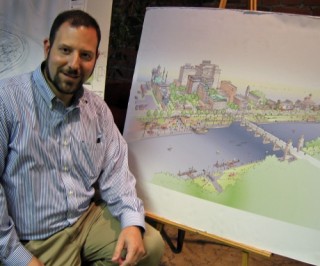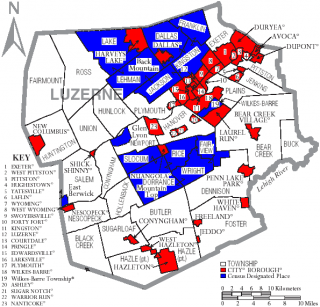by PCJ Editor Wayne Senville, reporting from Scranton, Pennsylvania
In thinking about my visit to the Scranton / Wilkes-Barre region, I heard about a number of challenging land use and development issues. But one group that seemed to be missing from the picture was planners. You know, the kind of folks who have studied city planning and often have “AICP” after their names.
Instead, the planning “action” seems largely to be driven by the two major Chambers of Commerce, and other economic development groups (such as Penn’s Northeast).

I met on Friday morning with Teri Ooms, Executive Director of the Institute for Public Policy & Economic Development. Started with a challenge grant from Wilkes College, the Institute now partners with nine of the area’s colleges and universities.
One of its missions, as Ooms explained, is to bring together regional leaders (from the business community, the political world, and academia) to focus on four key regional issues: education, jobs & the economy, housing, and land use & transportation.
“Our job is to convene and facilitate discussions,” Ooms noted. She is also looking to promote interlocal service agreements, something that’s rarely done right now.
Yet Ooms, who previously worked in California, is still surprised by the scarcity of planners in the area. “There’s very weak planning capacity at the county level,” she told me, “because there is a need for more resources to support planning.” As far as Ooms is aware, there’s only one “AICP” planner in the two counties (with a total population of 521,000).

When I met later in the day with Larry Newman, Vice President of Community & Economic Development of the Greater Wilkes-Barre Chamber of Business and Industry, he explained that community-based economic development is largely the function of the two major Chambers of Commerce.
There’s apparently a long history to this, growing out of the collapse of the anthracite coal industry in the late 1940s and 1950s, when this part of northeastern Pennsylvania became a national leader in developing models of community economic development (such as the Scranton Plan) to deal with the severe economic decline.
Another major hurdle to planning is the multitude of cities, boroughs, and townships, many of them quite small in size. There are 40 in Lackawanna County and 76 in Luzerne County. Newman says this makes it very difficult to deal with problems regionally.

When I spoke with Austin Burke, long-time President of the Greater Scranton Chamber of Commerce, about this, he sighed and said “you cope with it, you work around it.” To Burke, the problem is too deeply ingrained — in Pennsylvania law and in custom — to invest time trying to fix.

Newman’s assessment was not much different than Burke’s. But he sees potential opportunities for increased regional approaches to land use — something that’s come to the fore with the recent Luzerne County / Wilkes-Barre flood control project (more on this fascinating project in a separate post, Punching Through the Walls).
While in Wilkes-Barre I also met with Linda Trompetter and Arthur Breese, both of whom are involved with the Luzerne County Diversity Commission, a group trying to promote the benefits of ethnic and racial diversity in business and government. Trompetter noted that nepotism in local government is not uncommon, where jobs and appointments “are often based on family connections.” This makes it even more difficult to involve minorities in local government bodies, such as planning commissions. See also my post, Leadership for Diversity, for more on this Commission.
Who’s planning for your region’s future?